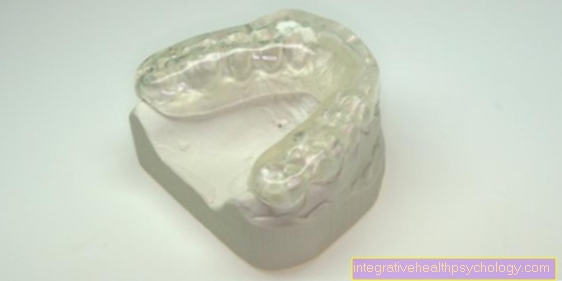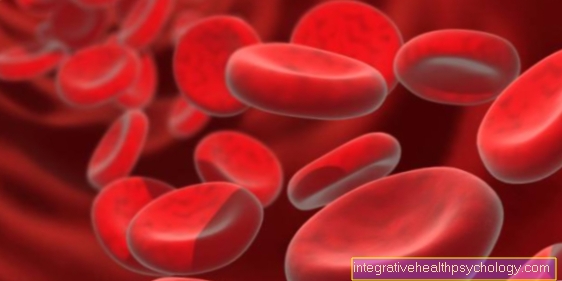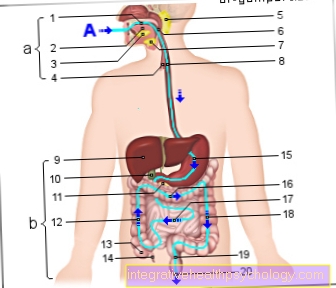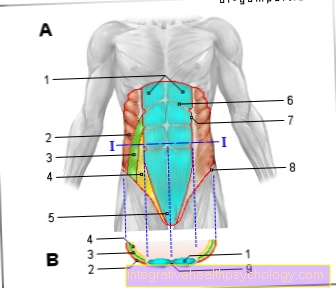Mastectomy
Definition - What is a mastectomy?
The term Mastectomy refers to the surgical removal of the entire mammary gland on one or both sides.
There are different forms of mastectomy, which differ in their radical nature and the structures of the breast to be removed. The most common reason for a mastectomy is breast cancer in women, but there are a number of other indications.
After the mastectomy, surgical reconstruction of the breast is usually performed.

Indications for a mastectomy
The most common reason for a mastectomy (removal of the mammary gland) in women is breast cancer.
Depending on the size, aggressiveness and malignancy of the tumor, it is not sufficient to remove the tumor area and thus preserve the breast in the treatment of breast cancer. In these cases, the affected breast is removed.
Different surgical techniques are used depending on the case. More rarely, benign breast tumors are so large that the only possible surgical treatment is removal of the breast.
Please also read: What types of breast cancer are there?
Another reason for a mastectomy can be an excessively enlarged breast (Breast hypertrophy, Hypermastia). The women affected often suffer from severe back and neck pain, poor posture and skin changes in the area of the breasts, so that ultimately only surgical breast reduction is an option.
With this so-called Reduction mastectomy the volume and weight of the breast are reduced to a reasonable level. If both breasts are affected, two operations are often performed a few months apart.
Read also: Breast reduction
An enlargement of the mammary gland in men (gynecomastia) can also be an indication for a mastectomy. A hormonal imbalance (testosterone deficiency, estrogen excess) leads to gland growth in the male breast, which is often perceived as being cosmetically very disturbing.
A so-called prophylactic bilateral mastectomy is recommended in certain cases in which the risk of breast cancer in the family is greatly increased.
Read more about this: The breast cancer gene
What types of mastectomy are there?
There are various forms of mastectomy, which differ in their radical nature, i.e. the degree of tissue removal. The different forms are therefore used for different indications.
In the subcutaneous mastectomy the entire breast is removed, leaving the skin and nipples, including the areola.After the operation, the image of a male breast emerges, which, however, can be restored to its original shape by reconstruction.
In the simple mastectomy In addition to the mammary gland, a flap of skin that also contains the nipple, fatty tissue and the fascia of the pectoral muscle on which the mammary gland rests are removed.
The modified radical mastectomy also includes removing the axillary lymph nodes. It is often carried out for breast cancer, as there is a risk that tumor cells have already settled in the axillary lymph nodes. It is considered the standard procedure for breast cancers that cannot be operated on to conserve the breast.
The radical mastectomy (after Rotter-Halsted) also includes the removal of the large pectoral muscle (M. pectoralis major) and is rarely used nowadays.
Which diagnostics should always be performed before a mastectomy?
Which diagnostics must be carried out before a mastectomy depends on the respective clinical picture.
In the case of breast cancer, it is essential to distinguish between benign (e.g. fibroadenoma) and malignant (breast cancer) changes.
To this end, a mammography examination is used first, which often reveals indications of the malignancy or benign nature of a suspicious area. An ultrasound examination of the breast is often used as a support.
In unclear cases or to determine the extent of a finding, MRI (nuclear spin) is used less often.
Read more about this at: MRI of the female breast
Ultimately, however, often only a tissue sample (biopsy) be sure to differentiate between benign and malignant tumors. This distinction largely determines the surgical technique and the use of further diagnostics.
In the case of a malignant tumor, the so-called sentinel lymph node is often determined before the operation. This is the first point of contact for tumor cells that spread and must be examined during the operation. If it is infected with cancer cells, other lymph nodes (especially in the armpit) must be removed, there is a lymph node metastasis.
Read more about this at: Lymph node involvement in breast cancer
Course of a mastectomy
A mastectomy (removal of the mammary gland) is usually performed in a larger hospital that has a gynecological (gynecological) department.
If the mastectomy is performed because of the indication of breast cancer, surgery in a breast center is recommended in many cases, as further care (radiation, chemotherapy, pain therapy, etc.) is ensured here on an interdisciplinary basis.
Read more about this at: Therapy for breast cancer
A mastectomy is always performed under general anesthesia and as part of an inpatient stay of several days.
There are various types of surgical technique that differ in their radical nature (see above). Depending on the infestation and disease, only one or both mammary glands are removed. The glandular body and other structures (depending on the surgical procedure, e.g. lymph nodes) are removed through usually a single skin incision.
In the case of a malignant tumor, lymph nodes are examined for tumor cells under the microscope during the operation (so-called Quick cut). If there are already cancer cells in the examined lymph nodes, further lymph nodes in the drainage area of the mammary gland must be removed.
Please also read: Lymph node involvement in breast cancer
Towards the end of the operation, which can take several hours depending on its extent, the incision edges are placed against one another without tension and closed with a suture. A drainage tube is also inserted, which ensures the drainage of blood and wound secretion.
The surgical wound is now bandaged in a sterile manner and the patient is transferred to the recovery room to wake up.
Duration of a mastectomy
How long a mastectomy takes depends on the scope of the surgical procedure and, of course, whether one or both of the mammary glands are removed.
In general, mastectomies for benign diseases (benign tumor, cosmetic surgery for oversized breasts) have a shorter duration than so-called oncological operations in breast cancer.
This is because in the case of breast cancer, additional structures such as lymph nodes must be removed and examined for malignancy.
An uncomplicated unilateral mastectomy can be over after an hour, but in more complicated cases of cancer treatment the mastectomy can take several hours.
Often the duration of the operation cannot be precisely estimated before the start, as the findings and the complexity only become fully visible during the operation.
Aftercare
A mastectomy is followed by an inpatient stay in the hospital for several days. Here it must first be monitored that the surgical wound does not become inflamed or that complications such as bleeding occur.
The patient also receives appropriate pain medication.
The drainage tube can then be removed after a few days.
After an average of 4 to 7 days, the patient can be discharged for further outpatient treatment, provided there are no complications.
The sutures of the surgical scar can usually be removed after approx. 14 days, depending on the type of thread chosen by the surgeon. This can also be done by a general practitioner or gynecologist. With so-called absorbable threads, pulling is not necessary, as they dissolve by themselves in the course of the wound healing.
If the operation was performed on the basis of the breast cancer diagnosis, radiation, chemotherapy and / or hormone therapy usually follows. As a rule, a so-called therapy concept decides on the exact therapy concept before the operation Tumor board (Association of experts from various fields).
Read more about this at: Therapy for breast cancer
Special bras after mastectomy
There is now a selection of special bras for women who have had a mastectomy. Depending on whether the mammary gland had to be removed on one or both sides, the bras have inner pockets in which prostheses (e.g. gel cushions) can be inserted.
The prostheses and bras are available in different sizes and shapes, thus enabling a natural result.
In addition, visually appealing and modern models are now available that also suit the tastes of different age groups.
After the operation, many women first receive a bra as first aid that supports the remaining tissue without incising uncomfortably or irritating the surgical scar.
For other bras and breast prostheses (e.g. stick-on inserts made of gel cushions), the statutory health insurance companies often cover the costs, as these are so-called aids. Many women use these mastectomy bras for the time between breast removal and breast reconstruction.
If the breast is not reconstructed, the special bras can be a permanent solution. In any case, a well-fitting bra with a suitable prosthesis allows many women to be more satisfied with their body and their own femininity thanks to a beautiful and natural cleavage.
How long is the healing time?
The healing time after mastectomy is very individual and depends on many factors. In young, fit and otherwise healthy patients, the healing process is usually much faster than in older patients with underlying diseases such as diabetes.
The radical nature of the operation (subcutaneous mastectomy vs. radical mastectomy) and the removal of other structures such as lymph nodes have a decisive influence on the course. Complications such as wound infections can also occur, which can further delay healing.
Usually the patient can be discharged home a few days after the operation. However, it is important to have adequate pain therapy and consistent further observation of the wound.
However, it can take months for the scar to heal completely. After about 2 weeks, the ability to work is usually restored and there is almost sufficient functionality in everyday life.
Sport can be practiced again after approx. 2 months.
However, if a mastectomy is performed for breast cancer, surgery is usually not the end of the treatment. Rather, radiation and chemotherapy and hormone therapy extending over several months are often necessary in order to be able to achieve a cure.
Scars after a mastectomy
How the scars run after a mastectomy depends on the surgical technique and the respective incision. In many women, the post-mastectomy scar runs horizontally across the entire area of the removed breast.
Of course, these scars cannot be completely avoided, but they can be minimized with a clean suture technique and adequate wound care after the operation.
How long are you in the hospital?
A general statement on the length of the inpatient stay after a mastectomy is not possible.
The length of the stay depends on the physical fitness of the patient before the operation (age, underlying diseases, etc.), on any complications of the operation and the pain after the operation.
On average, the hospital stay after mastectomy is several days (approx. 4-10 days).
Requirements for dismissal are
- a non-irritating, well-healing surgical scar,
- a good attitude with pain medication,
- a sufficient general condition
- and ensuring care and support in the home environment.
costs
The cost of a mastectomy, depending on the complexity of the procedure, the complications that occur and the length of the inpatient stay, can run to several thousand euros.
In addition, the costs vary depending on the clinic. While a mastectomy in men (due to gynecomastia) is comparatively cheap for purely cosmetic reasons (approx. € 2,000-4,000), the average cost of a cosmetic breast reduction in women is approx. € 4,000-7,000.
Due to special additional procedures such as a lymph node removal, the costs of a mastectomy for breast cancer are even higher. In such cases, however, the costs are always covered by the health insurance.
The health insurance company will assume the costs
Whether the costs of a mastectomy are covered by statutory or private health insurance or have to be borne by the patient depends on whether there is a medical indication for the operation or whether the procedure is to be carried out for purely cosmetic reasons.
In the case of benign or malignant breast tumors and, if necessary, prophylactically (see below), the mastectomy including the preliminary examinations, the inpatient stay and the aftercare is always covered by the health insurance.
Even if it can be proven that a breast reduction has a medical indication, e.g. due to chronic back pain, the operation can be paid for or subsidized by the health insurance.
In contrast, gynecomastia (feminization of the breast) in men and operations in trans men usually only have a cosmetic indication. In this case, the operation including the inpatient stay must be paid for by the patient.
What is a prophylactic mastectomy and how useful is it?
Under one prophylactic mastectomy one understands the (bilateral) removal of the healthy breast in women who have a high familial breast cancer risk.
A prominent example of this is Angelina Jolie, who had both breasts removed preventively a few years ago.
If there is an accumulation of breast cancer in a family and women who are already young, a genetic test can be carried out. If a so-called BRCA1 or BRCA2 mutation (BRCA = breast cancer gene) is present, the risk of an affected woman of developing breast cancer in her lifetime is up to 80%.
Such gene mutations are passed on from mother or father to their offspring and are the cause of up to 5% of all breast cancer cases.
If a corresponding mutation is detected, a prophylactic bilateral breast removal can be recommended at an early age before malignant tumors can form.
Since this mutation also increases the risk of ovarian cancer by up to 60%, removal of the ovaries and fallopian tubes is also advisable after family planning has been completed.
In a healthy woman without evidence of such a genetic defect, however, there is no justification for a purely prophylactic mastectomy.
Read more about this at: Breast cancer genes
Breast reconstruction
For many women, the removal of one or both breasts is associated with great psychological stress and restriction of their femininity and body image.
For this reason, many women opt for surgical reconstruction of the female breast. On the one hand, artificial implants are used, which are made of silicone gel or filled with table salt. These are placed just under the skin or implanted under the pectoralis major muscle.
Read more about this at: Breast implants
Another option is the so-called Flap plastic, in which the body's own structures are used to rebuild. Skin, fat and muscle tissue from other parts of the body such as the back (e.g. latissimus dorsi muscle) or the abdominal wall are used to build up a new chest.
Which method is preferred can be decided individually and in discussion with the treating gynecologist. In addition, it is often necessary to reconstruct a new nipple. For this purpose, a nipple can be recorded with a tattoo or e.g. reshaped from parts of the nipple on the opposite side. As a rule, a satisfactory optical result can be achieved for the patient.
Please also read: Breast reconstruction
When will it be reconstructed - immediately or later?
In the case of immediate breast reconstruction, the mammary gland is removed together with the tumor in one and the same operation, and a breast augmentation is carried out immediately afterwards using artificial implants or the body's own tissue. The advantage of this procedure is obviously that the patient wakes up from the operation with two breasts, which is a great benefit, especially from a psychological point of view.
However, immediate breast augmentation is associated with a longer operation time and possibly an increased rate of complications, so that it is out of the question for very sick and unstable patients.
In such cases, breast augmentation surgery should not be performed until several months after the mastectomy, preferably after the cancer treatment has been completed.
If radiation is also necessary after a mastectomy, the breast augmentation should only take place after it has been completed, otherwise complications such as capsule formation around the implant will increase.
Read more about this at: Irradiation for breast cancer
How painful is a mastectomy?
During the mastectomy, the patient is under general anesthesia. No pain is felt during the operation.
In the further course of the hospital stay, attention is paid to an adequate supply of painkillers. Whether pain nevertheless occurs and how severe it is depends primarily on the person's individual sensitivity to pain and the radical nature of the procedure.
Usually there is mild to moderate wound pain, which can be managed well with common painkillers (e.g. morphine, novalgin, ibuprofen).





























